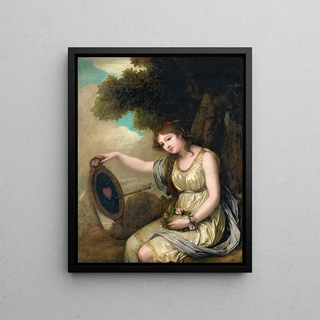Art print | Young Girl Sitting - Jean-Baptiste Greuze


View from behind

Frame (optional)
In the world of art, some works manage to transcend their era to touch the soul of those who contemplate them. "Jeune Fille Assise" by Jean-Baptiste Greuze is one of those creations that, through its charm and delicacy, invites deep reflection on beauty and human nature. This piece, created in the 18th century, embodies the very essence of the Rococo movement, but it goes far beyond simple ornamentation and frivolities often associated with that period. By delving into Greuze's universe, one discovers a unique sensitivity, a capacity to capture authentic emotions that still resonate today.
Style and uniqueness of the work
"Jeune Fille Assise" stands out for its intimate approach and delicate treatment of light. The composition, focused on the expressive face of the young girl, reveals meticulous attention to detail. The nuances of colors, ranging from soft tones to subtle shadows, create a warm and soothing atmosphere. Greuze excels in portraiture, and here, he manages to convey a fragility mixed with inner strength. The facial features, tinged with melancholy, evoke a psychological depth that invites the viewer to reflect on this character's inner life. Through his aesthetic choices, the artist manages to establish a dialogue between the artwork and the audience, making each gaze on the canvas unique and personal.
The artist and his influence
Jean-Baptiste Greuze, an emblematic figure of 18th-century French painting, established himself as a master of portraiture. His style is characterized by an ability to combine realism and idealization, offering a nuanced vision of his subjects. Trained at the Royal Academy of Painting and Sculpture, Greuze develops a distinctive artistic language that highlights human emotions and moral values. His works, often imbued with tenderness and compassion, have influenced many artists, both nationally and internationally. By exploring themes of family, education, and human relationships, he contributed to shaping an aesthetic that still resonates in contemporary art.

Matte finish

View from behind

Frame (optional)
In the world of art, some works manage to transcend their era to touch the soul of those who contemplate them. "Jeune Fille Assise" by Jean-Baptiste Greuze is one of those creations that, through its charm and delicacy, invites deep reflection on beauty and human nature. This piece, created in the 18th century, embodies the very essence of the Rococo movement, but it goes far beyond simple ornamentation and frivolities often associated with that period. By delving into Greuze's universe, one discovers a unique sensitivity, a capacity to capture authentic emotions that still resonate today.
Style and uniqueness of the work
"Jeune Fille Assise" stands out for its intimate approach and delicate treatment of light. The composition, focused on the expressive face of the young girl, reveals meticulous attention to detail. The nuances of colors, ranging from soft tones to subtle shadows, create a warm and soothing atmosphere. Greuze excels in portraiture, and here, he manages to convey a fragility mixed with inner strength. The facial features, tinged with melancholy, evoke a psychological depth that invites the viewer to reflect on this character's inner life. Through his aesthetic choices, the artist manages to establish a dialogue between the artwork and the audience, making each gaze on the canvas unique and personal.
The artist and his influence
Jean-Baptiste Greuze, an emblematic figure of 18th-century French painting, established himself as a master of portraiture. His style is characterized by an ability to combine realism and idealization, offering a nuanced vision of his subjects. Trained at the Royal Academy of Painting and Sculpture, Greuze develops a distinctive artistic language that highlights human emotions and moral values. His works, often imbued with tenderness and compassion, have influenced many artists, both nationally and internationally. By exploring themes of family, education, and human relationships, he contributed to shaping an aesthetic that still resonates in contemporary art.






